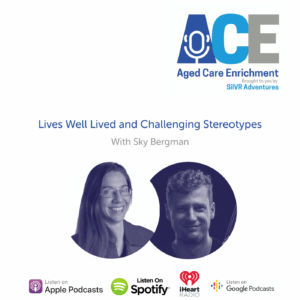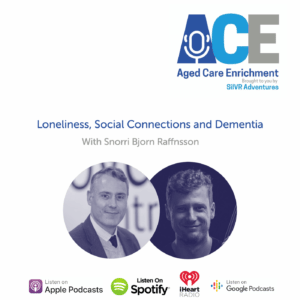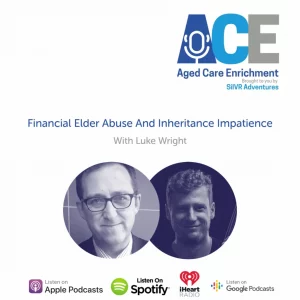Flora Proverbio is a Silver Economy consultant, strategic advisor to the Buenos Aires Government and thought leader for women over 50 in Latin America with her community Plateadas.
Transcript
Ash de Neef: Flora, thank you so much for joining us on the program.
Flora Proverbio: Thank you, it’s a pleasure to be here.
Ash de Neef: Yeah, it’s great to have you. And you’re calling in all the way from Argentina today. Could you tell us a little bit about you and your work and give our listeners some of your backstory?
Flora Proverbio: Okay. I’m Flora Proverbio, I work with the 50 plus segment. I help corporations and clients to harness all the economic opportunities from the silver economy. I worked in advertising for almost 20 years. I worked here in Argentina, I worked in the US in New York and in Florida. And I worked for many consumer goods companies handling the regional business and the global business for developing countries.
So when I was almost 48 years old, I was handling a business unit. And so my position was moved to London, I didn’t get an offer to move to London. And I thought I’m in the best moment of my career. I felt that I had seniority, I felt that I had more time to work because my children, well they weren’t babies anymore. I had emotional resilience, a lot of soft skills that I had developed. I had global experience.
So I thought that it was going to be so easy for me to get an interesting job. And I pictured myself actually refusing a lot of incoming offers, and it wasn’t like that. What happened to me? I got some interesting offers, but I realised that during the interview process, I had to kind of demonstrate that I was still in shape.
Ash de Neef: What do you mean still in shape?
Flora Proverbio: Still in shape meant that I wasn’t obsolete despite my age. That I had the ability to handle digital campaigns, that I understood the digital world how technology has changed all the corporate culture during the last decade.
I found that so absurd, you know, so crazy. Like I was feeling that I was in my best moment and the environment was treating me like I was – as if I had reached my expiration date. So I decided to go on my own. And at the same time that I was going through this experience in my personal life, my dad also started having a lot of cognitive issues. It was very tough you know, what happens in a family when suddenly in an unexpected way you become a caregiver.
So suddenly I was like, going through these two personal situations. And I found this very interesting and I started studying about demographic shifts, what’s going on, and I started studying based on that. And I decided to specialize in consumers 50 plus, although you can say 50 plus is like a huge chunk of people. But I decided to take 50 as a tipping point because I feel that is the moment in which society decides that you start your way into becoming less relevant.
I also helped the government of Buenos Aires City with public policies that aim to the integration of older adults in the working market. So with them, I developed two programs. One is a program in which we try to help companies hire people that are 55 plus, and again, overcoming the barriers, on both sides. The barriers from the applicants and the various from the company. So I try to bridge that and understand what the journey of the working person is, and try to overcome the pain points. And make sure that relationship can unfold without friction and become a reality.
And with the government of Buenos Aires also, I develop a program for micro entrepreneurs, female micro entrepreneurs, helping them create projects that allow them to have an economic impacts in their lives, in their families, in society. Because you know that it’s very hard for someone in their fifties to find a job.
Ash de Neef: Fantastic. So much stuff to dive into their Flora, you’re covering lots of different areas with your work. I’d really like to, just for the moment, focus on the work you’re doing with the Buenos Aires government. And it must be really nice to have gone through that journey yourself of looking for work and encountering this resistance because of your age, to now be helping people overcome that specific issue?
Flora Proverbio: It’s great, and a lot of what I went through helped me. And I know also, because the fact that I’m with the government is like, people are willing to speak with me. A lot of doors open for me that they wouldn’t open it another way. So last year I ran a big piece of research in which I interview a lot of people from human resources, pn the south cone – the south cone is Chile, Uruguay, and Argentina, like the south cone of Latin America.
And so that helped me understand what the pain points along the journey are. As I said before, it’s not only about hiring. Is what happens within the hiring process? What happens during the on-boarding process?
How does someone that is older than most of the people in our company, how does someone learn about the culture? And you know that every culture has a lot of unwritten. And so perhaps it’s hard to get into the culture, if all the folks belong to a different age group. And then what happens when people try to grow in companies?
So there are a lot of micro behaviors that make it very hard for someone that is older to really be able to make the most of that experience. But what I learned is that on the other side, there are also many resistances or behaviors that need to work as well.
So when I started this process, I was all about like, “no corporate cultures need to work to change.” But then I realized that people that are in, like in my age group also need to change some behaviors or perceptions or the way in which sometimes they don’t express what they feel or what they think.
So it’s not only working with the perceptions of the younger ones towards the older ones. It’s also working with the older ones about the perceptions that they have of themselves. Because those models in which people think that after 50 you can’t learn or you are out of shape or you are less innovative – it’s not only that younger people think that.
People in my age group, sometimes we think that about ourselves also. So it’s working with the culture and try to make both groups, try to understand each other.
Ash de Neef: Yeah, absolutely. It’s trying to eliminate that the stigma from outside and also the self stigma that older adults, or adults over 50 might hold themselves. I’m wondering because you lived in the United States for a number of years and working across different segments of the economy there and, in Argentina – is there a difference in the way that older adults are perceived in the U S as compared to Argentina?
Flora Proverbio: There is a difference in everything. Because United States is a powerful rich country and Argentina or Latin America is not. What I mean is that there is a way in which older adults are perceived. There is a way in which children are perceived. There is a way people access health, security, everything.
In the United States, not everyone, but you have a huge percentage of the older adult population that has a lot of disposable income and older adults are the group with higher Income and with more disposable income in the economy. So suddenly everyone is trying to sell stuff to them.
And I would say that in Argentina or in Latin America, we are going now with some delay through something different, but the amount of people to whom you can sell stuff is much smaller. Cause a lot of the population lives under the line of poverty or a lot of our population is struggling with their income.
The fact that a lot of people are struggling with their income has many, I want to say consequences, but impacts life in many ways. And I’m the biggest difference that I see is that in the states, people retire because they want, and in Latin America a lot of people can’t retire. I mean, They get to their retire retiring age, but they continue doing some kind of stuff.
Not because they want some of them, they want to have a personal project and they enjoy working and whatever, but many of them have to continue doing working or some kind of informal work because they need to earn some money. On the other hand, you can say well, that keeps them busy and having something to do keeps you healthy and it’s great to have something to do so it might have a positive impact as well.
Another big difference that I see is…although I want to say Latina medic is tainting and staging very fast because , The way in the, in which the population is organized, is changing very fast. And the population is changing as Latin America is the region that is changing and ageing the fastest.
But still in Latin America if you compare it with Europe or with the US, I don’t know how it is in Australia, we tend to be much more about the family. So a lot of the care is provided by the family. And the lower, the economic level of the family the more chances you have to have multi-generational homes. But that again, that is changing. If you think of families that are like middle class or upper class, you don’t have multi-generational homes.
And that is changing because houses are shrinking. Family size is shrinking. We have a lot of women that now have entered the working force. So women tended to be the primary caregivers, but now most of the women work. So what is going to happen with older adults with those women are in there to provide care? So we see the care industry is booming.
And so again in Latin America, you could say that you have two different societies. It’s a very polarized society.You have a lot of people under the line of poverty. Those people, they can’t access care, like they can’t access a lot of things. And then you have half of the population that is middle class or upper class, and those people can access care, private medicine, and as I said, because the population is ageing very fast we see a lot of industries that suddenly are shifting their offering and trying to reach this group of people.
And we also see a big entrepreneur ecosystem of senior entrepreneurs. So there is a booming economy, and also many groups of people over 60, trying to start their own companies. Or trying to start their own companies to target people on the same age group. And this is changing very fast, like it’s happening right now.
Ash de Neef: Yeah, I’m wondering with, you mentioned that one potential difference is the kind of focus on the family is slightly different in Latin America. I’m wondering if even when you have adults over 50, who have disposable income to be sold to, I wonder if their interests are slightly different to those in the states, if there’s more of a family focused than there is in America,
Flora Proverbio: I don’t know – It might be. When I moved to the states, it surprised me because in one side, yeah. I was very used to go for example, to a restaurant and see tables with people from different generations. And in the US for me it was surprising because I wouldn’t see that. You know, like people would see their grandparents once a year. People move to another city, they even see their parents once a year. I thought that was sad.
But also I see that in Latin America, we tend to think that grandparents have the kind of, obligation to take care of their grandchildren. We see a lot of women, especially lower income classes, a lot of women that are able to work, but they are able to work because their own mums are taking care of their children. Women work because grandmothers are taking care of their children. I don’t know if it’s better or if it’s worse, because on the other hand, we tend to have a very strong social support net that perhaps in developed countries and people don’t have.
And also, I mean, being a grandmother, is it an obligation or should be a pleasure and a decision? Now we’re having these kinds of conversations in Argentina, and you can see those kinds of articles in the newspaper, like obligation or pleasure? It tends to be that it was an obligation and now some women are saying like, “no, wait, I don’t want to have to take care of my grandchildren. I’m going to see them only when I want.” But it is also true that grandchildren keep you busy, occupied, happy, they give you tons of love. And those things are important to have a healthy aging process.
So I wouldn’t say that necessarily is worse, but. I don’t have that romantic view that is better, like having a family to take care of. A family is also a lot of obligations and in multi-generational homes, despite the romantic view that people have that, “oh, in Latin America, a lot of people live with their elder ones.” Or “that is great, they don’t put them in an institution”. But older folks are not that happy when they live in the same home with their children and with their grandchildren.
Especially in homes where there is not a lot of disposable income, because what happens is that those elder folks, perhaps they end up in a small room. They can’t put their own rules, they can’t decide when they want to do whatever they want to do. And in terms of, like I was saying that the population is aging very fast in Latin America.
For example, the process that in Europe today, 60 years in Latin America is happening in 25 years, so this is very fast. And now we have a lot of industries that are booming and something that is booming is the housing industry. I don’t know in Australia, but in the states we have a lot of co-housing projects. And in Buenos Aires right now many things like these are being developed. And there is a building for people 65 and older, close to my house. And they ended up building it last year and they sold all the apartments, like really fast. So first people were saying like, “nobody would like to live in a place that is all for old people.”
Yes, but old older folks, want to live with older folks and have fun and enjoy that. There are many learning communities that are being developed. There are many social places that are being developed, like bars, places to have fun, to listen to music. So from social offerings, care offerings, architecture, many industries are being developed and booming.
Ash de Neef: Fantastic. Well, It sounds like, traditionally, maybe older adults, might’ve been a bit in the background or in the shadows, and now they’re giving, getting a chance at least in Argentina to come out. I want to pivot Ethnos Strategy now, and your work consulting with companies to help them embrace the perspectives of older adults.
How do you bring in the perspectives of people over 50?
Flora Proverbio: So I always say to my clients that there are three things that companies can do to connect with this audience. The first one is do research and understand them. Really understand, put yourself in their shoes and understand their values, their behaviors, their perspectives, and then speak with them in a way that it engages. And again this is obvious and this works for absolutely every target, it’s not rocket science what I’m saying.
But what happens, like I said before, it’s because many companies are made by younger folks. When I have this conversation, I usually have this conversation with people in their thirties, in their forties who are kind of afraid to think of themselves as older folks. Like they are in denial. Think of my future self is something like “no, no, no. I don’t want to think about that.”
So many times when they speak to this audience, they speak with a load of stereotypes or negative ideas. And they end up saying these things that from my perspective are stupid. Like whatever, like “60 is the new 40”. Like trying to say like, “okay, older folks, we speak to you, but we know that somehow you are still young at heart.” Which from my, perspective is wrong.
60 is not the new 40. We are going through a new way of living our sixties our seventies, but it’s not the new 40. 40 is 40, 60 is 60. So the first thing is run research, understand them and understand their values in this life stage and their values towards the category that you are selling.
The second thing that you can do, so that is communication, how you connect with them, the storytelling that you project about these lifestyle, what you propose to them, the role models that you create or you propose.
The second thing that you can do is evolve that product or service to cater this audience. For example, let’s say you have a restaurant, Okay. How can we redesign that experience to make sure you’re not leaving anyone out? Whatever, perhaps you have, your cups of coffee are hard to handle and someone who has arthritis or Parkinson’s is going to be discriminated by the cups of coffee that you have. And their experience is going to be horrible and tough because the cups that you are too thin are discriminating against people.
So let’s see how your branches are designed. Let’s see how the benefits of the product that you have, how are you communicating those? For example, last week I was in a workshop with a food company. They had these cereal bars and usually cereal bars are hard, but we were in a workshop and they were trying to think how they could sell a new kind of cereal bar that was very soft. When you bite it is very soft.
And they were struggling like, “okay, this is for older people, you know that they can’t buy hard stuff. So how can we say, this is a cereal bar for older people?” And I was like, “perhaps you don’t need to say that it’s a cereal bar for older people. If someone has issues with their teeth, and those issues are related to age, they already know that they have issues with their teeth and that they can’t bite hard stuff.
If you just say that the cereal bar is soft, you are evolving your communication to cater this target in a way that you aren’t even like pointing at them, you know? So how can you evolve what you have to embrace this target? Perhaps incorporate small changes, make your … type the letters in your label make them bigger. Make the lead easier to open.
I’m not asking you to develop a new product, just those little details that you can change and make it more inclusive. So that is the second thing. The first one is engage with them in a way that is respectful and nice. The second one is you can evolve what you already have, incorporate small shifts and make your offer more engaging.
And the third one is, okay let’s design for the target and new product and new service. And there, because I have this community of people over 50, we do a lot of design thinking and we design not for the target, but with the target.
Right now, there is a company of games for older adults works for cognitive disorders, et cetera, and they are designing their own line platform. So we are working with older adults and working with them to shape the user experience and they give us feedback and we incorporate that feedback. So those are like the three kind of offerings that, that we do in terms of products and services with companies.
Ash de Neef: Yeah, that’s fantastic, and flora, we’re coming up towards the end of time and I wanted to see if you want to talk a little bit more about Plateadas.
Flora Proverbio: Yes Plateadas is my online community of women over 50. I mean I’m very passionate about this group and I, love the relationship and the daily conversations I have with them. And what I try to do there is empower women and fight against ageism and stereotypes. And it’s very interesting because women like get the worst of two worlds because we have all the gender stereotypes that left us behind. But also we have all the ageist stereotypes.
And what I try to do is to empower them. I try to use some sense of humor, you know, to make it light and invite them to embrace themselves, embrace their wrinkles.
We speak a lot about sex, about pleasure about all these ideas that somehow, that are still in our society. Things are changing very fast, but this idea that menopause is the beginning of the end of our pleasure. So I work with many people that, you know, sexologist or something.
I’m not a doctor, I’m not a sexologist, I’m not a psychologist. So I always try to work with someone else to help women understand that our brain and our clitoris don’t stop working with eight. So our, we are able to feel pleasure all our life and to embrace that wonderful gift of nature. And we have a lot of fun doing that.
I also invite women to embrace their wrinkles, and I feel that bright hair is having a mainstream moment right now. You know like in film festivals, you see famous people with their grey hair and that is great. So I think that the next step should be wrinkles having a mainstream moment. So I invite them to rock their wrinkles, use shiny lipstick, and feel beautiful. I think that in a society that tells us that when we should feel ashamed of what we see in the mirror, feeling beautiful and pretty is a political response that changes everything.
Ash de Neef: Yeah, fantastic. Flora we’ve covered heaps today. Thank you so much for your time, where can people find out a little bit more about you and your work?
Flora Proverbio: LinkedIn of course you can look for Flora Proverbio in LinkedIn. If you want to see what I do with Plateadas in Instagram, again with my name, Flora Proverbio.
I also have a podcast is in Spanish, eh, with a gerontologist who is called Diego Bernadini. It’s called the second half, La Segunda Mitad. Let’s say that the second half of life. And we speak also about the, all the wonderful opportunities of life after 50.
Ash de Neef: Absolutely. Well Flora thanks so much for your time today.
Flora Proverbio: Thank you very much.






